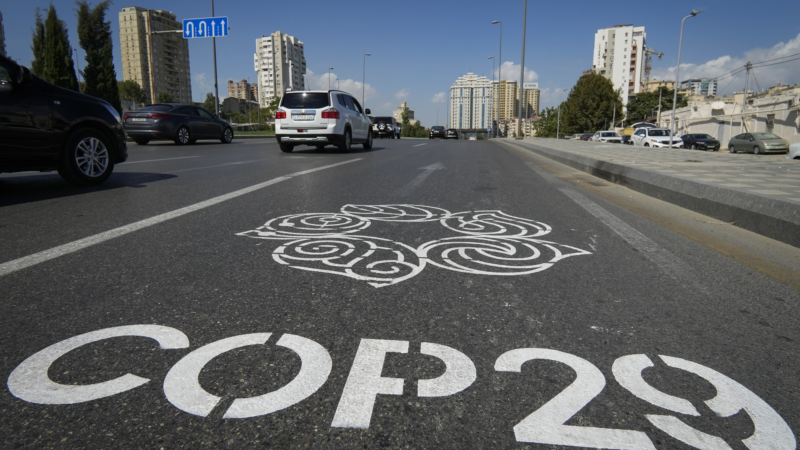Trump’s reelection casts a shadow over the start of global climate negotiations
Global climate talks started today in Baku, Azerbaijan, a major oil and gas producing country that borders Russia and Iran on the Caspian Sea.
The annual meeting is a chance for world leaders, as well as scientists, activists and corporate executives, to hash out plans to rein in global warming, and to prepare communities for threats they already face from rising temperatures. But Donald Trump’s return to the presidency in the United States, the biggest historical contributor of greenhouse gas pollution heating the planet, raises questions about whether the country will continue working on global climate initiatives.
At the end of last year’s conference in Dubai, negotiators struck a breakthrough agreement for countries to transition away from fossil fuels, the chief source of heat-trapping pollution. But Trump has promised to boost U.S. fossil-fuel production. And even before Trump reclaimed the White House, the United Nations warned that efforts to curb climate pollution are far off track. Global emissions rose to a new record in 2023, and scientists in the European Union say it’s “virtually certain” that 2024 will be the hottest year on record.
Against that backdrop, money will be a focus of the UN climate summit in Azerbaijan, known as COP29. The world needs to spend huge sums to overhaul entire economies that still mostly run on fossil fuels, and to deal with risks countries face from extreme weather. The needs are especially urgent in developing nations, which bear little responsibility for global warming but already face crushing losses as the climate changes.
Yet, nowhere near enough is being spent — by governments, corporations or organizations like the World Bank and International Monetary Fund — even as climate scientists say the clock for averting the worst threats from global warming ticks down.
“I remain very optimistic on the technology side,” says Rich Lesser, global chair of Boston Consulting Group. “The challenge is that the timeline to do this is not set by us.”
Here’s what you need to know about the issues and stakes in the next two weeks of climate negotiations.

Why is this meeting happening? And what’s it supposed to achieve?
Nearly 200 countries signed a treaty in 1992 called the United Nations Framework Convention on Climate Change. The agreement aims to keep human-caused greenhouse gas pollution from interfering with the Earth’s climate. Countries meet every year to discuss how they’re doing. The talks are officially called the Conference of the Parties, or COP. Since this is the 29th Conference of the Parties, it’s called COP29.
At the end of the 2015 COP meeting, world leaders signed the landmark Paris climate agreement.
It requires virtually every country to pledge how much planet-warming pollution they’ll cut and to update those plans every few years. The objective is to limit global warming to well below 2 degrees Celsius compared to temperatures in the late 1800s, and ideally, no more than 1.5 degrees Celsius in order to reduce the risks of escalating extreme weather disasters.
Right now, the world is nowhere close to hitting that target.
How does the U.S. election affect the talks?
Donald Trump’s victory is a big deal at this summit. He has called climate change a “hoax.” Trump has also suggested he will withdraw the U.S. from the Paris agreement, like he did during his first term.
“President-elect Trump has made very clear that he won’t wait six months to pull out of the Paris agreement like he did in his last term,” says Alden Meyer, senior associate at climate change think tank E3G. “He will pull out on day one.”
If the U.S. withdraws, the process takes a year. But the threat is already reshaping the diplomatic landscape. At the Baku summit, countries won’t rely on U.S. leadership as they would have if Vice President Kamala Harris had won the election, Meyer says.
“With Trump’s victory, I think people will be looking to see other countries, other leaders pick up the slack,” Meyer says. “Particularly the European Union and China.”
Countries are due to submit new pledges to reduce emissions early next year, which are supposed to be more ambitious than their last ones. But first, they need to come up with a new plan to help developing nations move off fossil fuels and deal with the impacts of global warming. That’s at the top of the agenda this year.

What were developing countries promised?
Industrialized countries like the United States built their wealth producing and using fossil fuels — and that’s driven most of the planetary warming so far. Developing nations, on the other hand, have contributed far less pollution. But they’re suffering disproportionate harm because of their smaller economies and geographic locations.
So in 2009, industrialized countries set a goal to give developing nations $100 billion a year by 2020 to help them deal with climate change. In 2015, countries extended the pledge to 2025. They also said they’d set a new goal that reflects the “needs and priorities of developing countries” before the old one expires. That’s the new target to be negotiated at COP29.
The problem is wealthy countries were slow to deliver. In 2022, they finally made good on their promise, providing developing nations with a record $115.9 billion in financing to cut climate pollution and adapt to rising temperatures.
That leaves developing nations in a bind. They need help, but whatever money is pledged will almost certainly be a fraction of what is needed. And they’ll be relying on wealthy neighbors that have been unreliable.
“I think for me, success is when the money is actually delivered,” says Vijaya Ramachandran, director for energy and development at The Breakthrough Institute. “What we really want to see is an increase in resources to poor countries that will actually enable them to tackle climate change. Instead, what we are seeing are these pronouncements.”
There’s also debate around a new “loss and damage” fund that was created last year to compensate vulnerable countries for harms they’re already suffering from climate change. While some countries have made pledges, payments have yet to be sent out as countries debate how the fund will be administered.
So, what are countries doing to cut emissions?
While countries’ new pledges to cut climate pollution even further aren’t due until February 2025, some countries are expected to announce theirs at the Baku summit.
At last year’s climate talks, participants agreed — for the first time — that the world needs to move away from fossil fuels like oil, gas, coal
But this year the world is investing even more money in exploring for and producing fossil fuels, according to a report from S&P Global Commodity Insights. President-elect Trump has promised to champion fossil fuels and cut investments for solutions that reduce climate pollution, like solar and wind energy, and large batteries. Trump said he will “terminate” Biden’s signature climate legislation.

How’s the world doing on other climate commitments?
At the COP28 meeting in Dubai last year, countries pledged to triple renewable energy capacity by 2030 and double annual energy efficiency improvements. The International Renewable Energy Agency (IRENA) identified this goal as necessary to achieve broader climate change goals and avoid some of the worst consequences of burning fossil fuels.
Nations agreed to triple the amount of installed renewable energy to reach 11,000 gigawatts by 2030. But a recent IRENA report shows that a year into that six-year goal, countries are not on track to achieve their pledges. It finds current plans would deliver only half of the pledged renewable power in 2030. The only sector on-track is solar panels, according to the report. Wind, hydropower, geothermal and marine energy are among those lagging far behind.
“It is still possible to achieve this goal, but each year the target falls further out of reach,” Francesco La Camera, IRENA’s director-general says. “We made a shared commitment at COP28. Now it is time for us to deliver.”
Countries will detail those commitments next year when they submit their larger pledges for reducing climate pollution.
Last year countries also agreed to double annual energy efficiency improvements “from around 2% to over 4% every year until 2030.” But IRENA reports there’s been little progress on meeting that goal.
Now Azerbaijan has set a new, ambitious goal for the summit — to increase global energy storage six-fold. Stored energy, often with batteries, can backstop renewable energy when the sun isn’t shining or the wind isn’t blowing.

What about the voices of Indigenous groups?
Indigenous people hold a sliver of power at these meetings. They can give advice to states that are willing to listen to Indigenous peoples’ desires and needs when it comes to negotiated text and agreements.
Eriel Deranger, executive director of Indigenous Climate Action and an Athabasca Chipewyan First Nation member, says Indigenous peoples are still largely relegated to the sidelines.
“It’s been really difficult, to be honest,” she said.
Graeme Reed, Indigenous North American representative for the Local Communities and Indigenous Peoples Platform at COP29, says his group will focus on ensuring that there’s no additional harm to Indigenous peoples and on building global Indigenous solidarity.
“To actually unchain ourselves from the colonial nature of the COP itself,” he said. “The COP is predicated on the erasure of Indigenous nationhood. It’s built around the upholding of state nationhood, and as a result, we won’t see significant change until the nationhood of Indigenous peoples is acknowledged and incorporated.”
Here’s how Trump and the GOP may try to weaken Obamacare
Republican control of the White House and Congress sets the stage for potentially seismic changes including curtailing Medicaid, weakening patient protections, and increasing premium costs for millions.
Richer countries are starting to pay poorer ones for climate change damages
With climate-related disasters getting more extreme, richer countries are piloting ways to compensate developing nations, since they bear the least responsibility for causing climate change.
Most of the country shifted right in the 2024 presidential election
In 2020, President Biden won six of the seven closely watched states. This year, President-elect Donald Trump won all seven — plus he will got a majority of the popular vote.
To hit deep inside Russia, Ukraine has built its own drones
President Biden has now given Ukraine permission to use U.S. ballistic missiles inside Russia. While it was waiting, Ukraine built its own drones that can strike far across the border.
UConn’s Geno Auriemma becomes the all-time winningest college basketball coach
Geno Auriemma has led the women Huskies to 11 championships and nearly two dozen Final Four appearances in his four decades as head coach.
A duct-taped banana sells for $6.2 million at an art auction
A piece of conceptual art consisting of a simple banana, duct-taped to a wall, sold for $6.2 million at an auction Wednesday, with the winning bid coming from a prominent cryptocurrency entrepreneur.

